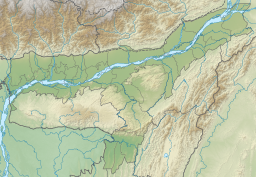
The Irrawaddy dolphin is a euryhaline species of oceanic dolphin found in scattered subpopulations near sea coasts and in estuaries and rivers in parts of the Bay of Bengal and Southeast Asia. It closely resembles the Australian snubfin dolphin, which was not described as a separate species until 2005. It has a slate blue to a slate gray color. Although found in much of the riverine and marine zones of South and Southeast Asia, the only concentrated lagoon populations are found in Chilika Lake in Odisha, India and Songkhla Lake in southern Thailand.

Kaziranga National Park is a national park in the Golaghat and Nagaon districts of the state of Assam, India. The park, which hosts two-thirds of the world's Indian rhinoceroses, is a UNESCO World Heritage Site. According to the census held in March 2018 which was jointly conducted by the Forest Department of the Government of Assam and some recognized wildlife NGOs, the rhino population in Kaziranga National Park is 2,613. It comprises 1,641 adult rhinos ; 387 sub-adults ; and 385 calves.

Mājuli or Majuli is a river island in the Brahmaputra River, Assam state, India. On September 8, 2016 an additional district was announced by Sarbananda Sonowal, it became the first island to be made a district in India. In the 1790s, the island covered an area of 1,300 km2 (500 sq mi). It had an area of 1,255 square kilometres (485 sq mi) at the beginning of the 20th century, but having lost significantly to erosion it covers 352 square kilometres (136 sq mi) as at 2014. Majuli has shrunk as the river surrounding it has grown.

Chilika Lake is the largest brackish water lagoon in Asia and second largest coastal lagoon in the world, spread over the Puri, Khordha and Ganjam districts of Odisha state on the east coast of India, at the mouth of the Daya River, flowing into the Bay of Bengal, covering an area of over 1,100 square kilometres (420 sq mi). Another lake in India called Vembanad Lake is the longest lake in India. Chilika Lake comes after the New Caledonian barrier reef. It has been listed as a tentative UNESCO World Heritage site. Its salinity varies by region, from nearly freshwater where rivers flow in, to oceanic salinity levels due to tidal influx.
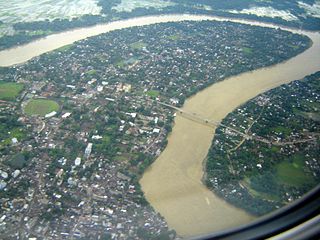
The Barak River flows 900 kilometres (560 mi) through the states of Manipur, Nagaland, Mizoram and Assam in India. Further it enters Bangladesh where it bifurcates into the Surma river and the Kushiyara river which converge again to become the Meghna river before forming the Ganges Delta with the Ganga and the Brahmaputra rivers and flowing into the Bay of Bengal. Of its total length, 524 km (326 mi) is in India, 31 km (19 mi) on the Indo–Bangladesh border and the rest in Bangladesh. The upper part of its navigable part is in India — 121 km (75 mi) between Lakhipur and Bhanga, declared as National Waterway 6, (NW-6) since the year 2016. It drains a basin of 52,000 km2 (20,000 sq mi), of which 41,723 km2 (16,109 sq mi) lies in India, 1.38% (rounded) of the country. The water and banks host or are visited by a wide variety of flora and fauna.
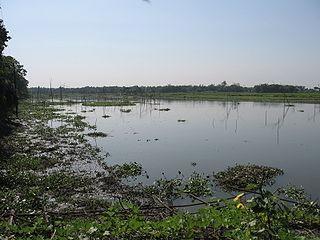
A beel is a billabong or a lake-like wetland with static water as opposed to moving water in rivers and canals - typically called khāls in Bengali, in the Ganges - Brahmaputra flood plains of Bangladesh, and the Indian states of West Bengal and Assam. The term owes its origins to the word of the same pronunciation meaning "pond" and "lake" in the Bengali and Assamese languages.

Dipor Bil, also spelled Deepor Beel , is located to the south-west of Guwahati city, in Kamrup Metropolitan district of Assam, India. It is a permanent freshwater lake, in a former channel of the Brahmaputra River, to the south of the main river. In 1989, 4.1 km² of the area was declared a wildlife sanctuary by the Government of Assam. It is listed as a wetland under the Ramsar Convention which designated the lake as a Ramsar Site in November 2002 for undertaking conservation measures on the basis of its biological and environmental importance.
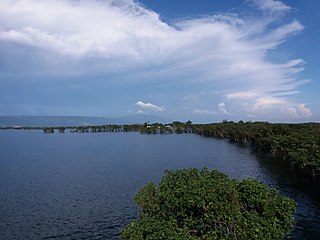
A haor is a wetland ecosystem in the north eastern part of Bangladesh which physically is a bowl or saucer shaped shallow depression, also known as a backswamp. During monsoons haors receive surface runoff water from rivers and canals to become vast stretches of turbulent water.

The baiji is a possibly extinct species of freshwater dolphin native to the Yangtze river system in China. It is thought to be the first dolphin species driven to extinction due to the impact of humans. This dolphin is listed as “critically endangered: possibly extinct” by the IUCN, has not been seen in 40 years, and several surveys of the Yangtze have failed to find it. In China, the species is also called the Chinese river dolphin, Han river dolphin, Yangtze dolphin and whitefin dolphin. Nicknamed the "Goddess of the Yangtze", it was regarded as the goddess of protection by local fishermen and boatmen. It is not to be confused with the Chinese white dolphin or the finless porpoise. This is the only species in the genus Lipotes.

Chakrashila Wildlife Sanctuary is a wildlife sanctuary falling under Kokrajhar district and some adjacent areas of Dhubri district of Assam, India. It is famous for the golden langur and is the second protected habitat for golden langurs in India.

The Turtle Conservancy (TC) is a conservation organization that aims to protect endangered turtles, tortoises, and their habitats worldwide.

Northeast India consists of the eight states Arunachal Pradesh, Assam, Manipur, Meghalaya, Mizoram, Nagaland, Sikkim and Tripura. Tourism in this area is based around the unique Himalayan landscape and culture distinct from the rest of India.
Salkocha is a village and gram panchayat in the town of Chapar in the Dhubri district of the state of Assam, India. It is part of the Bilasipara East Assam Legislative Assembly constituency and the Dhubri Lok Sabha constituency.
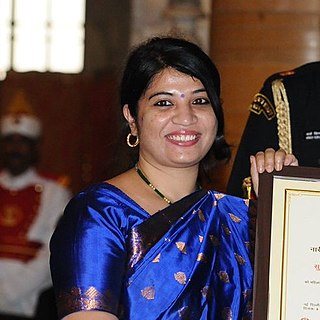
Purnima Devi Barman is a wildlife biologist from Assam, India. She is known for her conservation work with the greater adjutant stork, known locally as the Hargila. She is the founder of the Hargila Army, an all-female conservation initiative. In 2017, Barman was the recipient of both the Whitley Award for her conservation efforts and the Nari Shakti Puraskar, the highest women-exclusive civilian award, presented by the President of India.
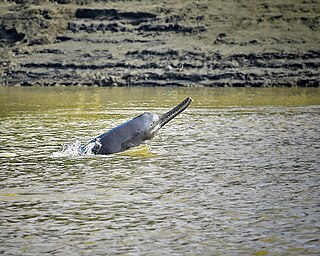
The Kulsi River is a tributary of the Brahmaputra River in the Indian state of Assam. The river originates from West Khasi Hills of Meghalaya. The river is known as Khir River in its origin. After travelling 12 km in Meghalaya, the river then flows through Kamrup district of Assam and is known as Kulsi. The confluence of the Kulsi with Brahmaputra River is at Nagarbera of Kamrup district, Assam.
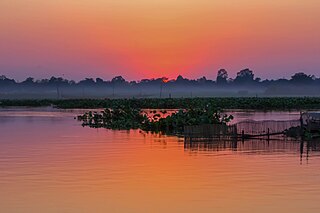
Maguri Motapung Beel is a wetland and lake located near Dibru-Saikhowa National Park and Motapung Village of Tinsukia district in Assam. Maguri Motapung Beel serves as a natural home to wildlife and provide a source of livelihood to the local communities.
Silsako Lake is a wetland and lake located at the heart of the Guwahati city and surrounded by villages like Satgaon, Hengrabari and Mathgharia in Kamrup Metropolitan district of Assam. Guwahati Water Bodies Act 2008 has specifically notified the Silsako Lake in the Schedule I to IV along with six other wetlands of Guwahati.

Urpad Beel is a natural lake located at Agia village in Goalpara district of Assam. This lake is situated 9 km away from Goalpara, the district headquarters of Goalpara district. Urpad Beel is one of the biggest natural lakes of Lower Assam.

Samaguri Beel is a ox-bow shaped (U-shaped) wetland and lake located near to Nagaon town in Nagaon district of Assam. This Beel is situated in the Brahmaputra river basin. This lake is formed by the abandoned path of the Kolong River.

